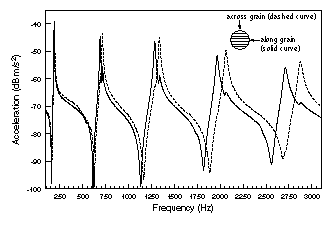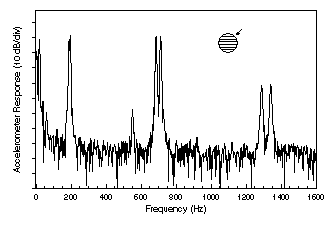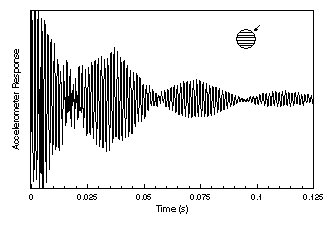What did surprise me was that I found two bats for which the frequency perpendicular to the grain was lower than the frequency parallel to the grain, exactly the opposite of what I would have expected. I did find two Little League bats, one ash and the other maple, which were both hand carved from quality wood (I had to special order them) which had no audible difference in frequency and which showed very little mode splitting even for the higher bending modes.
What effect does this mode splitting have on a bat's performance? My guess that the primary effect, if any, would be in the perception of feel, especially for hits which are not directly aligned with the wood grain. . The middle figure at right shows the frequency spectrum measured by a mirophone for an impact at 45o to the grain. When the impact is aligned with (parallel to) or perpendicular to the grain only one frequency is heard. But when the impact is at an angle, both frequencies are excited equally and a strong beat frequency is heard. The bottom figure at right shows the vibration response at the handle of the bat, measured with an accelerometer, for an impact at 45o at the barrel end. The beat frequency is observed as the envelope of the vibration signal (think of the "wah-wah-wah" pattern for a beating sound). A player who is holding the bat will feel this beat pattern. The hands are most sensitive to vibrations with frequencies below 200 Hz.[4] Since this beat pattern is around 25Hz it would be very noticeable. It is true that the hands damp out the bat vibration very quickly (within a few tens of milliseconds), but the impulse felt as a "sting" for a bat hit may be exacerbated by a bat with this mode splitting beat phenomena.

Frequency Response Functions for impacts parallel to the grain (solid curve)
and perpendicular to the grain (dashed curve).

Microphone response for an impact at 45o to the grain direction.

Beat pattern, measured with an accelerometer at the handle of a bat
for impact at 45o to the grain at the barrel end.